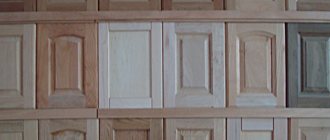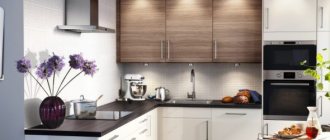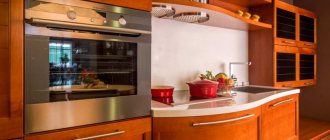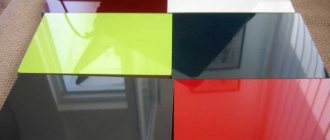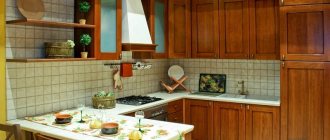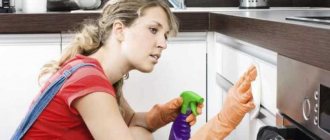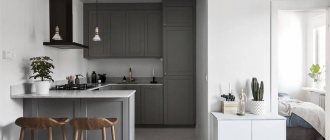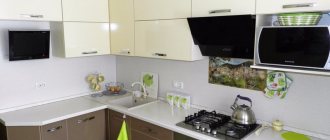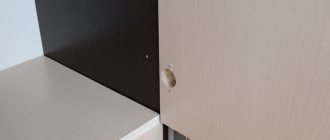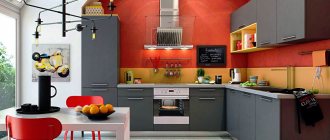What is a furniture facade
The facade of cabinet furniture is understood as the totality of all visible parts facing its front, and sometimes side, surface. The facade ultimately determines the appearance, cost, and attractiveness of furniture for the consumer. The area of facade parts on average does not exceed 30% of the area of the parts that make up the product. The cost of the facade is approximately 25-30%, and can reach 80% of the price of the entire product.
The facade includes several main types of parts: doors, front walls of drawers, vertical and horizontal decorative overlays, cornices, etc. All furniture fronts can be classified according to numerous characteristic features, for example, by style, appearance or design. Facade doors are their main constituent element.
It is easy to change the appearance of furniture by simply updating the facades. Replacing facades is not a difficult task. The fastening is usually designed in such a way that the facade is easy to unfasten, replace with a new one and adjust the latter vertically, horizontally, as well as its inclination. In this case, the fastening part - the so-called filler part - remains in its place, and another facade is mounted to it. Drawer fronts are also quickly replaced. A variety of reasons lead to the decision to change facades, both prosaic - wear and tear due to careless use, damage by active children, direct exposure to sunlight, improper use of detergents, etc., and more sublime - the thirst for change, renewal, often associated with repair.
Structural and technological classification of facades
For a furniture manufacturer, the most preferable classification, primarily of doors, is based on design and technological characteristics. This makes it possible to simplify the understanding of the production technology of a facade of one type or another.
The simplified classification of furniture facade doors, which is given in Appendix 1, shows that facades can be divided into: - solid (panel, or also called “blind”), consisting of almost one part, - prefabricated frame-panel construction, including a frame and a panel, which from a technological point of view is a solid facade.
The consumption structure of facades is as follows: solid (panel) - 62%, composite (frame-paneled) - 38%.
Types of furniture facades
The range of most manufacturers usually includes facades that not only differ structurally, in style and design, but are also made of different materials, using different technologies. The range of facade materials is extensive. These are panel materials (chipboard, MDF), solid wood, furniture panels, metal (usually stainless steel and aluminum), glass, acrylic and even ceramic tiles (for kitchens in construction) in all its diversity.
The most familiar one from Soviet times is laminated chipboard. Today it is used in the economy segment. A more expensive option is MDF in a variety of finishes: veneered, film-coated, paneled, painted. A fairly new and expensive offer on the market is facades made of aluminum profiles with almost any filler: glass, plastic, rattan, etc. And the list concludes with premium class facades made of solid wood of various species - an expensive classic pleasure. New products using natural materials (leather, fabric, plant fibers), photo printing, 3D canvas, etc. are also appearing on the market.
Chipboard facades
Manufacturers of chipboard (chipboard) over the past decades have managed to significantly improve its consumer qualities. True, no revolutionary changes have occurred: it is still covered with laminate (more durable) or melamine (less durable). German chipboards (emission class E1) are recognized as the best. The new generation of particle boards have increased density and are water resistant. For the manufacture of facades, 1st grade slabs with a thickness of 10-26 mm are used. Today, furniture facades made of chipboard (chipboard) are the absolute leader in terms of sales.
Modern technologies make it possible to make postforming and softforming facades based on particle boards. Postforming
- This is a modern material consisting of chipboard laminated with plastic.
Softforming
is a high-quality melamine chipboard with a “crystal” and “wood pore” surface.
For the production of facades, chipboard slabs, as a rule, arrive already covered with a laminate. It is this coating that makes the chipboard façade resistant to external influences, friction, scratches, and household chemicals. The popularity of chipboard is largely due to the fact that the decorative coating successfully imitates the color and texture of various types of wood. Chipboard facades are subject to mandatory certification, since formaldehyde resins are used in the production of wood-based panels. When used for a long time, such facades release formaldehyde, which is harmful to humans.
The “bottlenecks” of any chipboard products are the unclosed edges of the boards. Therefore, manufacturers that respect themselves and their customers cover all edges, even those that face the wall or are located at connection points. “Bare” ends are one of the signs of cheap furniture. An aluminum mortise end profile is also used to protect open ends.
Pros. Chipboard is an inexpensive board material with good characteristics: products made from it are durable and easy to use. A rich range of colors for facing materials, inclusion of glass in the composition, framing of facades with aluminum profiles - all this will help create aesthetic and practical inexpensive facades.
Minuses. Chipboards are quite loose inside and do not allow for fine processing. As a rule, chipboard facades are straight, but rounded end modules, bent facades, and carved parts cannot be made from chipboard.
MDF facades
MDF (fibreboard) is stronger than chipboard.
It is comparable to the strength of natural wood and even surpasses some species. It can be given convex, volumetric shapes, which cannot be done with chipboard. MDF frame facades
- This is a structure consisting of an MDF profile, which is covered with PVC film.
Often the MDF profile is made textured like wood with an internal insert (glass, plastic, MDF panel). A wide range of profiles of different sections makes it possible to produce facades that differ in appearance. The ability to combine the colors of the frame and internal filling makes the color palette of the facades very wide. In the manufacture of frame facades there are no problems associated with dimensions, which makes it possible to produce facades of any non-standard size. The MDF frame facade does not warp, does not swell, and retains its original shape when the temperature changes. The only drawback is the seam connection. MDF facades covered with PVC film are produced by milling MDF blanks and then laminating them with PVC film using hot membrane vacuum pressing technology.
It is possible to produce flat and volumetric (relief) facades, as well as curved facades. There is a large selection of colors and types of coating, both glossy and textured, from different manufacturers. The inner side of the facades in the standard version is white. Facades made of glossy MDF board coated with UV varnish or high-gloss PVC film with several layers of protection are easy to manufacture. The slab must be sawn and the ends processed either with a glossy edge or edged with an aluminum end profile.
The color palette is varied and includes not only plain and woody, but also fancy decors.
Painted facades
They are a base made of MDF, onto which acrylic dyes and varnishes are applied using complex technologies, followed by polishing. The customer can choose from a wide range of colors and shades of paint (according to the RAL and WOOD COLOR catalogues), as well as several types of painting effects (starry sky, chameleon, mother of pearl, pearl, matte, gloss). It is also possible to produce bent (curvilinear) painted furniture facades and painted facades in aluminum profiles.
Pros.
MDF facades are durable (they hold fasteners well), do not swell, do not warp, and in terms of moisture resistance and mechanical characteristics they sometimes surpass even natural wood.
And another important factor is the environmental friendliness of the material. The boards are produced without the use of phenol-containing binders. Flexible, durable, homogeneous in structure, MDF lends itself to the finest processing methods and can take on various shapes. Minus.
The inside of the facades in the standard version is white, which is not always acceptable.
Aluminum profile facades
The aluminum profile facade
consists of two components: an aluminum frame and filling. The profile of the frames can be of different sections, both wide and narrow and with rounded edges. The filling can be almost any materials (glass, plastic, MDF, etc.) and their combinations. Profiles filled with various types of glass – stained glass, textured, mirrored, and with decorative films – look very interesting. Stylish aluminum frames in a variety of colors combined with the transparency and purity of the glass give the furniture a fresh and original look.
Pros.
A distinctive feature of such facades is that they are extremely moisture resistant, which allows them to be used as facades for bathroom furniture.
Minus.
The disadvantages of aluminum facades include their cost. With the current development of aluminum production, facades made of this material are inferior in the price range to solid wood, MDF and chipboard.
Solid wood and veneer facades
Furniture facades made of solid wood
belong to the time-tested classics. Most often, wood species such as oak, alder, pine, beech or acacia are used in their manufacture. Solid wood facades can be made in various color variations. Modern technology makes it possible to apply various artificial effects to furniture facades, such as, for example, the effect of aging wood.
Solid wood furniture fronts remain popular among adherents of the classic style, as they combine practicality and the feeling of good quality furniture made from a solid natural wood slab. Recently, more and more manufacturers are offering various panel options, which allows them to be used in the Art Nouveau style. This type of processing of solid furniture facades is the most acceptable and common for lovers of natural wood in a modern design.
However, facades made of solid wood are extremely rare - they are expensive and unpredictable in operation. Manufacturers most often make facades from type-setting wood - dried wood is cut into bars and assembled into panels using a special technology. Such elements are less susceptible to external influences.
Veneered facades
cheaper than those made from solid wood, less capricious in operation, but visually retain the warmth and texture of natural wood. In addition to the veneer of popular species - oak, cherry, beech, birch, walnut, maple, chestnut - exotic veneers are used for finishing: anegri, zebrawood, makore, wenge, makassara, teak, etc. This veneer is not similar to any existing wood species — it has its own “face” with a clearly defined original structure, effective pattern and color. Most often, in framed (panelled) facades, natural veneer is used to cover the frame.
Veneer is a thin layer (0.6-3 mm) of wood produced by peeling, planing or sawing logs. Sliced veneer is considered the most expensive. Today, modified sliced veneer, made by planing a block glued together from rotary cut veneer, is more common. Veneered boards must be coated with a protective varnish coating.
Pros.
Solid wood facades are environmentally friendly and can have any shape and decor.
Wood is combined in the interior with all materials. Finally, she knows how to age gracefully. In addition, solid wood surfaces can be restored. Minuses.
Wood is sensitive to sunlight (can change tone), humidity, temperature and may warp. It is difficult to predict how solid wood facades will behave in our far from stable climate and with air-drying central heating turned on most of the year.
Other types of facades
Fashion trends exist not only in clothing, but also in furniture. Out of the desire to surprise, hook the buyer and offer unique products, manufacturers are developing more and more new types of facades.
Facades with 3D milling
– a new trend in the furniture market.
The surface of such facades imitates the texture of natural wood bark, sand dunes, waves, symmetrical patterns and even flames. 3D facades are made from MDF 19 mm thick, covered with any PVC film (wood, plain, glossy, metallic, chameleon, holographic and even the new Tactus special effect), and also painted in all the colors of our decor cards (with the exception of the mother-of-pearl effect). Facades covered with leather, artificial or even natural, are a novelty in the production of furniture facades.
Such facades look beautiful, impressive, and most importantly, practical and functional, since the leather is quite easy to care for. Polymer photo printing on facades is a new word in the furniture industry. Due to its functionality, photo printing has a wide range of applications. This is the production of cabinet furniture, kitchens, interior partitions, interior decoration, retail premises, etc. Modern technologies make it possible to apply a photographic image to almost any hard surface. The latest UV paints with nanoparticles used in our work are more resistant to aggressive environmental influences, ultraviolet radiation, and therefore fade much more slowly when exposed to direct sunlight.
Any photographs can be used in the manufacture of such products. Photo printing on furniture facades allows you to achieve amazing results, creating exclusive furniture of amazing beauty in single copies. With the help of such furniture it is easy to create an original interior design without resorting to complex technical techniques and large financial costs.
Types and forms
MDF can be divided into several types depending on the surface treatment method. Slabs sanded on one or both sides are well suited for putty and paint. They are most often used for finishing walls and ceilings. Panels with a thickness of more than 12 mm can also be used for floor finishing; they are used instead of laminate.
PVC film is made from synthetic polyvinyl chloride, which becomes plastic when heated. Under the influence of vacuum, the heated film is pressed tightly against the facade blank, and when it cools down, it retains the resulting relief.
Veneered boards are boards covered with thin cuts of wood (veneer). Such slabs are very similar to solid wood of valuable species, and therefore their price is quite high.
Another type of MDF, which is used primarily in furniture production, is panels covered with plastic.
They do not fade under the sun and are easy to clean with any cleaning products, which is especially important for kitchen furniture. Plastic panels allow the production of curved contours and rounded shapes
3D panels are a new product on the building materials market. Processing of such facades is carried out not only along the contour, but also in depth to the surface. Using milling, various patterns “like wood”, “like waves”, “like sand dunes” are created on the front surface of the facades. The second option for achieving a 3D effect is to repeatedly paint MDF, which is then laminated or covered with veneer.
According to their shape, MDF can be divided into three types:
- Slatted - panels 15-32.5 cm wide and 240-270 cm long. Light strips of material, similar to long laminate boards.
- Tile - square panels with dimensions from 30x30 to 95x95 cm, similar to large ceramic tiles.
- Sheet - moisture-resistant panels with a height of 2800, 2440, 2344 and 2070 mm, a width of 1220, 1035 and 695 mm. They resemble a wall surface lined with small and medium tiles.
Dimensions of furniture fronts
The market is characterized by a wide format (height, width) range, allowing you to choose a façade to suit any “color and taste”. Typically, manufacturers adhere to a certain standard range of sizes, but there are companies that produce facades of almost any size to order. The possible size of the facade is significantly limited by the material from which it is made. Frame facades usually have a certain minimum possible size, depending on the size of the profile used. The maximum size of MDF facades lined with PVC film is limited by the capabilities of the equipment used. Facades made from slab material are characterized by the widest range of sizes, limited only by the size of the original slab.
Colored laminated MDF board
The colors of laminated MDF can be absolutely any. The main advantage of PVC film is that it can be created with absolutely any pattern and shade. The assortment is simply colossal. Manufacturers produce the following laminated materials:
- transparent and translucent films with a “lace” pattern, reminiscent of stained glass or glass decorated with a frosty pattern. An unusual decoration method is used on radius parts of facades or individual components as an accent
- dense monochrome films in bright pure or pastel colors. More than 200 options are possible in smooth and textured designs. Manufacturers offer 12 different options for white color alone (boil white, ivory, pearl and others)
- films with patterns imitating solid wood, marble, fabric, metal. With the help of such films, quite interesting products are created, for example, embossed, 3D, metallized, patinated or brushed.
Experts note that the most popular finishes among clients are bleached oak, natural or stained walnut, ash, and cherry.
